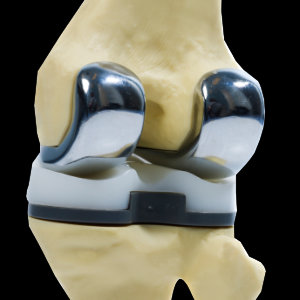A total knee arthroplasty is the same as a 'total knee replacement'.
 Page updated February 2024 by Dr Sheila Strover (Clinical Editor)
Page updated February 2024 by Dr Sheila Strover (Clinical Editor)

Arthro- means relating to a joint; -plasty means refashioning. So the word means 'the re-fashioning of a joint'. Usually this refers to the metal and plastic manufactured components, as in this photograph, but the word can also be used for any kind of joint re-shaping.
What are the indications for total knee arthroplasty (TKA)?
A total knee arthroplasty is a life-changing event, inasmuch as that joint is now forever dependant on doctors and hospitals if something goes wrong.
But patients will have battled for a long time with pain and anti-inflammatory medications, walking aids, physiotherapy, and injections - and find themselves willing to make the trade for a reduction in pain and improved mobility.
-
Quote from peer-reviewed paper:
Total joint replacement "....is an end-of-line treatment for patients with severe pain and functional limitations....The primary indication for TKR is pain, followed by functional limitation...."
Citation: Medical Advisory Secretariat. Total knee replacement: an evidence-based analysis. Ont Health Technol Assess Ser. 2005;5(9):1-51. Epub 2005 Jun 1. PMID: 23074478; PMCID: PMC3382388.
What are the main designs of total knee arthroplasty?
A total knee arthroplasty has three common components:
In terms of overall design there are three basic choices, depending upon the quality of the soft tissue supports at the time of surgery -
- non-constrained - where the patient's own ligaments and muscles provide stability for the new joint
- semi-constrained - where some stability is provides by the design of the prosthesis itself, but the patient's own tissues also enhance stability
- constrained - where the patient's own tissues are too weak and the prosthesis itself provides most of the joint stability.
How long does recovery take after TKA?
Patients are expected to walk with help within a day or two of the procedure, but full recovery takes several months.
What are the main risks of TKA?
One of the big risks of knee replacement is DVT or deep vein thrombosis (a clot in the leg). This can make the leg swollen and very uncomfortable, but the real danger is that a large clot can break off and shoot via the heart to the lungs, where it can cause life-changing symptoms or even death. Because of this risk, patients will be treated pre- and post-operatively with blood-thinning medications.
Another big risk is infection, as it is particularly hard to eradicate infection that has set in to a joint replacement. To minimise the risk the surgeons will operate in a special operating area with special airflow, and wear clothing and equipment that separates them entirely from contact with the patient during the procedure.
Longer-term issues include loosening of the prosthesis and post-operative stiffness.
Forum discussions
- Total Knee Replacement 10 months later and still in pain
Pain problems after total knee replacement
Relevant material -
 2018 -
2018 -